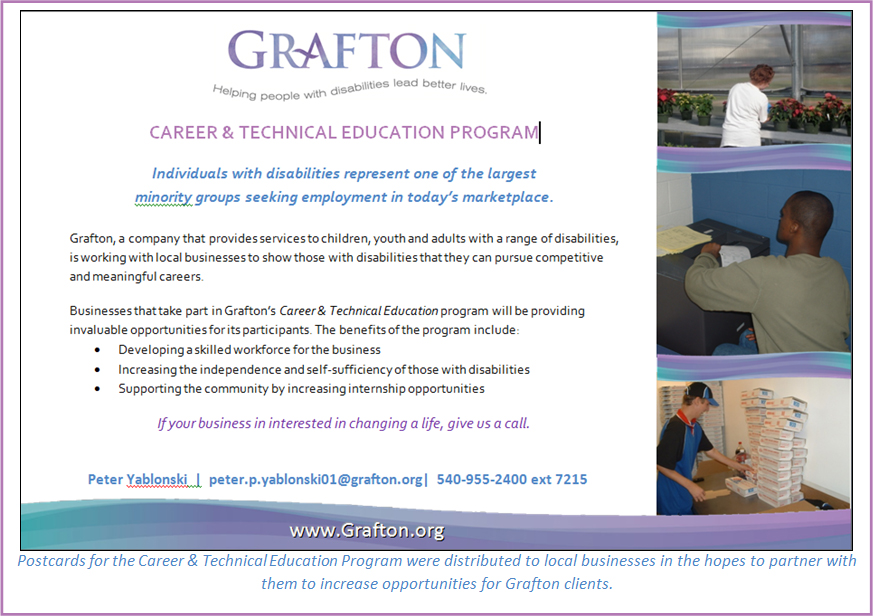Vol 2 • Issue 1 • Jan 2011

Individuals with disabilities represent one of the largest minority groups seeking employment in today’s marketplace. Three years ago, Grafton set out with a plan to better provide clients with concrete skills that would enable them to lead more independent lives and secure employment. Today, the Career and Technical Education (CTE) program has been redesigned and restructured to improve the quality of vocational instruction available to students. It’s growing quickly, with roots in Berryville, Richmond and Winchester, and students are flourishing. The objectives of the program are to increase:
- Career and technical education opportunities for students;
- Acquisition of vocational skills; and
- Learning opportunities for transitioning during the day.
We saw a tremendous need for this type of program. While other organizations across the state of Virginia create job opportunities for individuals with special needs, Grafton creates opportunities for individuals with the most severe and in many cases, co-occurring or multiple disabilities.
The vision was to create a day-to-day education milieu in which instruction is delivered from different areas of specialty–horticulture, food preparation, clerical, industrial arts, janitorial, and a “school based enterprise” or a specialty business. Each of Grafton’s facilities provides a different specialty business such as car detailing, a coffee shop and a linen service. Students in the program are even involved in the local food movement. The Berryville horticulture program grows specialty herbs for Ed Matthews, the chef and owner of One Block West Restaurant, a fine dining restaurant.

Within each area of specialty, teachers integrated core academic subjects – reading, writing, mathematics, science and social science – into skills-based instruction on preselected or aligned standards of learning. For example, when participating as part of the linen service, students receive training in several areas including sorting clothes, measuring and using detergents, operating machinery, folding and hanging garments on racks. They use sequential picture directions to wash and hang towels and clothes correctly. Writing skills are practiced as they complete work orders (e.g. “Pick Up in Room 106 and Return by 12:00 PM”) and through correspondence to customers. Math is utilized while tallying laundry, when measuring the cleaners and predicting time to complete wash and dry cycles.
As part of the program, career and technical education assessments are completed based on a student’s current level of functioning. This assessment yields recommendations based on a student’s specific needs. The recommendations are then translated to goals for the Individualized Education Plan (IEP) and transition plans as student’s become increasingly autonomous. About the assessments Grafton team’s conduct for individuals in the CTE program, a Richmond Department of Rehabilitation representative has this to say, “Grafton’s career and technical education assessment is one of the best documents I have ever seen and public schools should follow their model.”
The feedback from parents and businesses has been tremendous. Sara Schoonover-Martin, Executive Director, Healthy Families Northern Shenandoah Valley recently shared, “Healthy Families of NSV is grateful for the assistance provided by the students at Grafton in completing our annual mailing. The students at Grafton did a wonderful job. I am excited to see the expanding career and vocational programming offered at Grafton. What a great way to give back to the local community.”
I encourage area businesses to help us change the lives of individuals with disabilities in our community. Learning a basic skill like folding laundry has untold long term benefits for our clients. The tools they gain in the CTE program will serve them for a lifetime. We believe this program is truly beneficial for all involved. Businesses benefit by developing a skilled workforce for its business; Grafton students benefit by gaining increased independence and self-sufficiency.
Jim Gaynor
- Child Welfare – recognized Grafton’s clinical best practices in restraint and seclusion reduction in article, “Restraint Use in Residential Programs: Why are Best Practices Ignored? By Janice LeBel, Kevin Huckshorn & Beth Caldwell, Volume 89, No. 2. Click here for link to article.
- “Best Practices in Reducing Workers’ Compensation Costs” – presented by Tony Sanders, director of risk management at the Partlow Insurance Agency Worker’s Compensation Seminar on October 7th in East Brunswick, New Jersey and October 21st in Fredericksburg, Virginia.
- “Planned Change, Best Practice and Risk Management: Grafton’s Minimization of Restraint and Seclusion Initiative” – presented by Jim Gaynor, CEO and Kim Sanders, Executive Vice President & Chief Outcomes Officer at the VAISEF 2010 fall conference in Richmond, Virginia.
- Public education campaign for the Infant and Toddler Connection of Shenandoah Valley – announced as 2010 Platinum Winner by the Marcom Awards, an international competition for marketing and communication professionals and programs. The campaign was one of 20 to receive a 2010 Platinum Marcom Award in the category of Marketing: Promotion Materials.
- “The Minimization of Restraint Initiative” highlighting safe, non-coercive behavior management interventions and the resulting positive outcomes for clients, families, employees and the organization will be presented by Jim Gaynor and Kim Sanders in Melbourne, Australia February 7th through February 11th.
Feedback
We want to hear from you! Do you have something you want to tell us? Is there anything else you’d like to know about Grafton? Please share your thoughts by sending an email to communications@grafton.org.